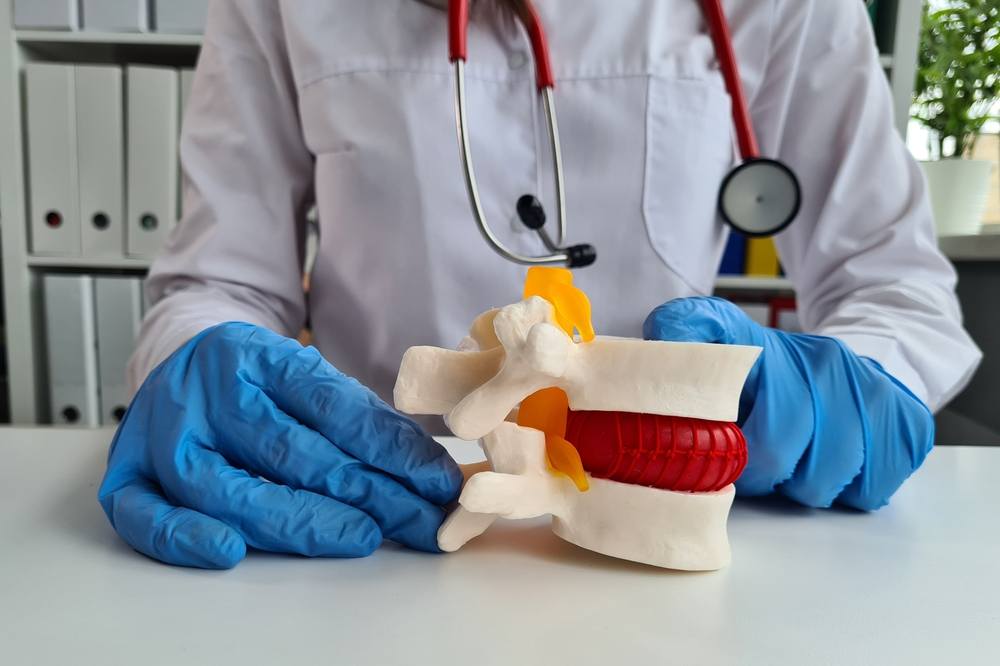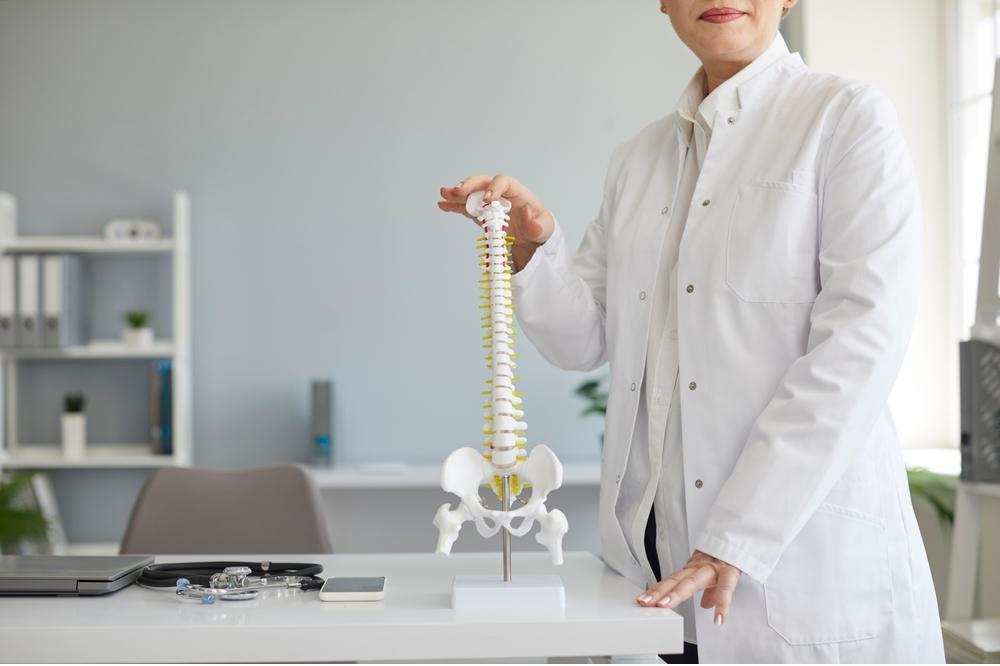 The human spine is made up of a series of bones called vertebrae that are stacked one on top of the other. In between these vertebrae are spinal discs that have a tough outer shell that protects a gelatinous inside, which helps with shock absorption and movement. The spine is divided up into four main areas: the cervical spine in the neck, the thoracic spine in the mid-back, the lumbar spine in the lower back, and the sacral spine at the base of the spine. An annular tear is a type of spinal injury that affects the spinal discs located in the spinal column. Damage to these soft, spongy discs can impact the support and function of the spine, causing a wide range of uncomfortable symptoms and issues. Here’s everything you need to know about annular tears.
The human spine is made up of a series of bones called vertebrae that are stacked one on top of the other. In between these vertebrae are spinal discs that have a tough outer shell that protects a gelatinous inside, which helps with shock absorption and movement. The spine is divided up into four main areas: the cervical spine in the neck, the thoracic spine in the mid-back, the lumbar spine in the lower back, and the sacral spine at the base of the spine. An annular tear is a type of spinal injury that affects the spinal discs located in the spinal column. Damage to these soft, spongy discs can impact the support and function of the spine, causing a wide range of uncomfortable symptoms and issues. Here’s everything you need to know about annular tears.
What Is an Annular Tear?
The outer layer of a spinal disc is called the annulus fibrosus, which functions as a strong, protective shell for the inner gel-like substance of the disc, called the nucleus pulposus. Damage to the outer layer, or annulus fibrosus, is known as an annular tear. An annular tear can occur for a variety of reasons and can lead to symptoms and complications that range from mild to severe. The spine has 33 vertebrae and 23 spinal discs that support flexibility and movement in the spine without the bones rubbing against one another. An annular tear can lead to uncomfortable symptoms and further spinal issues.
Annular Tear Locations
Annular tears can occur at any level in the spine, though there are certain locations that are more common than others. In the cervical spine, annular tears commonly occur at the C5-C6 and C6-C7 levels, which help support the head and neck. In the lumbar spine, the most common location for annular tears occurs at the L4-L5 and L5-S1 levels, which is where the spine helps support much of the body’s weight. Annular tears in the thoracic spine or mid-back region are less common. The location of the annular tear can impact the types of symptoms you experience.
Common Causes of an Annular Tear
 One of the most common reasons people go to the doctor each year is for back pain. Some common causes of an annular tear include trauma, degeneration, repetitive strain, and underlying conditions.
One of the most common reasons people go to the doctor each year is for back pain. Some common causes of an annular tear include trauma, degeneration, repetitive strain, and underlying conditions.
Trauma
One of the most common reasons why people suffer an annular tear is trauma. An injury or accident that damages the spine, like a car accident injury or fall, can lead to an annular tear.
Degeneration
Over time, the spinal discs can start to lose their elasticity and flexibility. As the discs begin to degenerate, it can make the annulus fibrosus more susceptible to tears. Degeneration is more common in older adults.
Repetitive Strain
Repetitive strain or overuse injuries, like from lifting heavy objects improperly or high-impact sports or activities, can also result in an annular tear. Certain activities can put too much pressure on the spine in negative ways and lead to damage or trauma like an annular tear.
Underlying Conditions
Underlying health conditions can also increase your risk for an annular tear. Certain conditions, such as osteoarthritis or spinal stenosis, can cause an annular tear to occur.
Signs & Symptoms of an Annular Tear
When the annulus fibrosus becomes cracked or torn, it can result in a variety of symptoms. The severity of symptoms of an annular tear will depend on the size and location of the tear.
Back Pain
Back pain is the most common symptom that occurs with an annular tear. Pain will typically occur in and around the location of the impacted spinal disc. For example, an annular tear that occurs in the cervical spine, or neck area, may cause sharp, stabbing pain or dull, throbbing pain in your neck that radiates into your upper back. Certain movements and activities can also increase pain in your back.
Leg Pain
Leg pain can also occur with an annular tear, particularly with a tear that occurs in the lumbar spine, or lower back. Damage to a spinal disc in the lower back can cause pain and discomfort that radiates into your legs.
Tingling & Numbness
An annular tear could result in the gel-like nucleus spilling out and aggravating nearby nerves along the spinal column. If a nerve becomes irritated or compressed, it can cause tingling and numbness that extends into your extremities.
Weakness
An annular tear could also result in weakness in the legs or difficulty walking. The nerves that control these types of movements could become damaged with an annular tear and cause this concerning symptom.
Risk Factors for an Annular Tear
There are several risk factors that can increase your risk of developing an annular tear, including your age, occupation, and level of physical activity. Annular tears are more common in older adults because of the natural degeneration that occurs in the spine over time. Certain occupations can also require more manual labor or repetitive movements that put additional stress and pressure on the spine. If you engage in high-impact sports or activities that put excessive strain on your spine, then you could be at greater risk for an annular tear. A previous injury to the spine can also make you more susceptible to an annular tear, including a herniated disc or spinal fracture.
Treatment Options for an Annular Tear
 Your treatment options for an annular tear will depend on the location of the injured spinal disc and the severity of your symptoms. Here are examples of common treatment options for annular tears:
Your treatment options for an annular tear will depend on the location of the injured spinal disc and the severity of your symptoms. Here are examples of common treatment options for annular tears:
Pain Management
Treatment for a minor annular tear may include pain management solutions like over-the-counter medications like NSAIDs (nonsteroidal anti-inflammatory drugs). Your doctor may also prescribe other medications to help with pain and inflammation. Steroid injections may also be recommended to help reduce more severe cases of pain and inflammation.
Chiropractic Care
Chiropractic care for an annular tear may include spinal adjustments, which are gentle and controlled movements of the spine performed by a licensed chiropractor. A chiropractor will work to restore proper alignment of the spine, including the vertebrae and spinal discs. They can also walk you through exercises or stretching to help reduce pain and improve mobility.
Physical Therapy
Physical therapy can play an important role in the healing and recovery after an annular tear. A physical therapist can provide you with stretches, exercises, and soft tissue mobilization to reduce your symptoms and improve healthy functioning. Physical therapy for an annular tear works to increase your strength and take the pressure off your spine so you can function optimally.
Surgery
In some cases, surgery may be necessary to repair an annular tear. The type of surgery will depend on a variety of factors, including the size and location of the tear. Surgery for an annular tear will require a more extensive healing and recovery timeline, likely including physical therapy.
Recovering from an Annular Tear
The recovery period for an annular tear will be affected by whether your treatment plan includes surgery. Your overall health and any previous injuries or health conditions can also impact your recovery time. In general, you should also follow any recommendations by your doctor for lifestyle changes to help speed up your recovery process. You should also avoid activities that put excessive strain on your spine while you recover from an annular tear. It could be a long process to recover from an annular tear, so you want a team of doctors by your side who you trust. You should also feel comfortable talking to your healthcare provider about any ongoing pain or other concerns you may have during the treatment and recovery process.
Preventing Annular Tears & Spinal Injuries
Thankfully, there are several steps you can take to reduce your risk of an annular tear and prevent this kind of injury. Maintaining a good posture helps to distribute pressure on your spine more evenly and keep the spine in proper alignment. Engaging in regular exercise also strengthens the muscles that support your spine and allows for healthy flexibility. You should also make efforts to avoid activities that put excessive strain on your spine. Always use proper lifting techniques for heavy objects to avoid damage to your spine. Maintaining a healthy weight is also important to prevent annular tears and spinal injuries. Staying hydrated and getting enough sleep also go a long way to helping your whole body function properly and reduce the risk of injuries like annular tears.
Visit AICA Orthopedics in College Park to get quality treatment and comprehensive care after an annular tear. Our team of doctors includes spine specialists who have the knowledge and expertise to treat mild, moderate, and severe annular tears. We also have a team of College Park car accident doctors who can help you recover from a car accident injury, including an annular tear. Always seek medical attention as soon as you can when you experience symptoms that could be related to an annular tear or another spine injury to get started on a treatment plan that will last and prevent further damage.